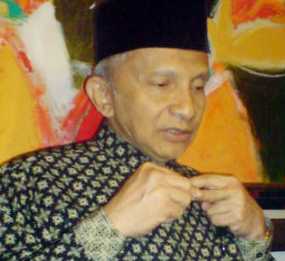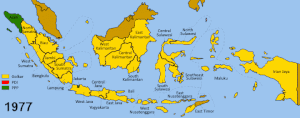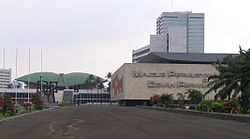Suharto: A Political Biography
R.E. Elson
Cambridge University Press 2001
A book review by
Danny Yee © 2002 http://dannyreviews.com/
In
Suharto Elson has produced a superb study of one of the twentieth century's most important leaders. It focuses, as the subtitle suggests, on the acquisition and development of Suharto's political philosophy and political skills and their expression in his career. Elson assumes a familiarity with Indonesian history: readers unfamiliar with the events of the
Indonesian Revolution will have some trouble understanding Suharto's career from 1945 to 1949, for example, and even after Suharto becomes president Elson is never tempted to start on a general history of New Order Indonesia. Despite the relatively narrow focus, however, the result is readable and quite involving. It helps that the structure is chronological, with little or no foreshadowing, though that also means that one almost needs to read the work twice. Suharto was born near Yogyakarta in Central Java, in 1921, but some mystery surrounds the details. He claimed to be from poor peasant stock but his education, connections with the lower echelons of government, and later indifference to his native village suggest he was the illegitimate son of someone relatively well-placed. During the war he joined Peta, the Japanese-organised Indonesian army, as a platoon commander. In the Indonesian Revolution he saw service around the headquarters of the Republic in Yogyakarta. This involved him in factional conflicts and coup attempts such as the 3 July Affair and the Madiun Affair, which contributed both to his distrust of civilian politicians and his opposition to communism.
Stationed in Central Java after independence, Suharto rose to command the Diponegoro Division. He acquired experience handling business connections and managing army cooperatives and foundations, and met many who would play important roles in his later career (including, during a stint in Makasar, Habibie, his eventual successor as president). In 1959 Suharto was sent to the Army Staff and Command School (he was one of the few among his peers who didn't go to the United States for training) and proceeded from there to high commands: first the Mandala command for the "liberation" of West Irian and then Kostrad, the army strategic reserve. Along with other officers, Suharto helped to stall Army involvement during the Confrontation with Malaysia and by 1965 he was a key player in the uneasy balance between the communist party, the armed forces, and Sukarno.
In 1965 came the 30 September/Gestapu coup attempt, which unleashed the pent-up tension. Elson carefully examines the evidence for what happened on October 1 and the following days, as well as both the mainstream interpretations (varying degrees of communist party involvement and planning) and more radical theories. While he rejects suggestions that Suharto himself was involved in the coup attempt, Elson sheets home to him the primary responsibility for the resulting
massacres. Following the coup came the destruction of the communist party and a complex power struggle between Suharto and Sukarno. The Supersemar decree of 11 March 1966 gave Suharto effective power well before his formal appointment as president in 1968, by which point many of the foundations of New Order Indonesia were already in place.
An early "honeymoon" saw the achievement of stability and some economic advances. Though Indonesian economic growth was critical to Suharto's success as leader, Elson barely touches on topics such as foreign investment, relations with the United States and the World Bank, the extent to which benefits reached those in poverty, or the rise of local capitalists. He is more interested in Suharto's idiosyncratic personal ideas about development and his management of conflicts between economic nationalists and technocrats.
Politically the early years of Suharto's presidency saw the curbing of the parties, the creation of Golkar, and the continued use of
anti-communist ideology and rhetoric to mobilise support. The corporatisation of politics and connections with Sino-Indonesian businessmen brought criticisms of corruption, however. The decade from 1973 was more difficult. There was discontent in the army elite, surfacing most notably in the Malari affair of January 1974, when Kopkamtib commander Sumitro allowed riots to get out of hand in an attempt to discredit opponents, and the 1980 Petition of 50, criticising army collaboration with Golkar. Other problems included continuing student and social unrest, the Pertamina scandal, and the occupation of East Timor.
In the decade following the 1983 presidential election Suharto enjoyed nearly undisputed ascendancy, despite controversies over an extra-judicial state terror campaign (the Petrus killings), army reforms, an oil crisis, the role of his children, and patrimonialism and corruption more generally. The 1988 elections saw the appointment of Sudharmono as vice-president, part of a broader move away from the army. As he aged, Suharto faced the loss of friends from his own generation (and in particular his wife Ibu Tien in 1996), a decline in personal ties to subordinates, and a general loss of touch. He fell back on his familiars and tried to find new sources of support: he promoted Habibie rapidly (though the army imposed Try Sutrisno as vice-president in 1993), indulged his children, tried to bolster his Islamic credentials (risking ethnic and religious sectarianism), and took a growing interest in his status as an international leader.
This leaves us with some idea of Suharto's own contributions to his rapid fall from power in May 1998, but Elson's account of that is brief: his focus on Suharto means he can't really address the broader forces involved. A final chapter gives an overview of Suharto's personality and legacy. Elson concludes that
The paradoxical legacy of Suharto's rule is that the transformations he tried to contain were a direct if unintended consequence of his efforts at social and economic modernisation.
In any event, understanding modern Indonesia still involves understanding Suharto — and for those who want to do that, Elson's biography will be essential reading. March 2002
source :http://dannyreviews.com/h/Suharto.html















